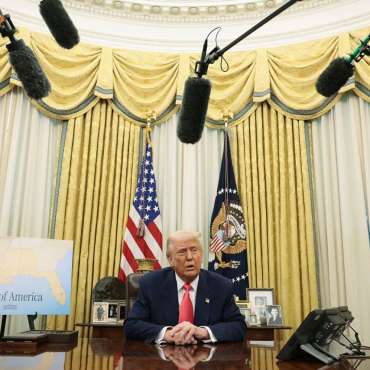President Donald Trump confirmed Monday that 25% tariffs on Mexican imports and 10% duties on Canadian goods will resume next month. The decision follows a 30-day suspension initially paused for border-security negotiations.
“Tariffs are going forward on schedule,” Trump declared during a White House press conference. Economists warn these levies could inflame inflation, disrupt supply chains, and drain $1,200+ annually from U.S. household incomes. Consequently, investors are fleeing volatile assets, including cryptocurrencies, amid fears of economic turbulence.
Crypto Markets Panic
Bitcoin plummeted 4.13% to $82,133 within 24 hours of Trump’s announcement, dragging Ethereum, XRP, and Solana down by 15-21%. Meanwhile, the global crypto market cap tumbled 4.72%, slipping below $3 trillion to $2.8 trillion.
Analysts attribute the sell-off to tariff-induced anxiety, triggering $650 million in leveraged liquidations. “Tariffs destabilise macroeconomic confidence, pushing traders toward safer havens,” noted crypto strategist Linda Park. Altcoins mirrored the plunge, with meme coins and DeFi tokens shedding 20% collectively.
Global Leaders Warn Against Trade War Escalation
French President Emmanuel Macron urged cooperation, stating, “We need prosperity, not a trade war,” during joint remarks with Trump. Similarly, Mexican President Claudia Sheinbaum expressed optimism about pre-deadline agreements but hinted at retaliatory measures.
Canada has already appointed a fentanyl czar to address Trump’s drug-trafficking concerns. However, Europe threatens counter-tariffs on U.S. tech and agriculture, risking a transatlantic standoff. “Retaliation could cripple growth worldwide,” cautioned Yale economist Mark Levin.
Economic Fallout
Walmart and automakers warn of price hikes as tariffs raise material costs. The University of Michigan’s consumer sentiment index dropped 10% last month, reflecting tariff fears. Furthermore, 68% of manufacturers anticipate slowed production due to pricier steel and aluminum. “Families will bear this burden,” said Retail Alliance CEO Laura Simmons. Despite Trump’s claim that tariffs will boost jobs, economists counter that trade wars historically shrink GDP and employment.
Tariff Details and Trump’s Strategic Rationale
Trump’s February executive orders targeted Mexican manufacturing and Canadian energy, citing insufficient border security. The paused tariffs required Mexico to deploy 10,000 National Guard troops and Canada to intensify anti-fentanyl efforts. However, Trump insists reciprocal tariffs matching foreign nations rates will begin in April.
These could exceed competitors levies by factoring in subsidies and VAT taxes. “We’re reclaiming fairness,” Trump asserted, though critics label the strategy economically reckless.
Retaliatory Threats and Long-Term Market Uncertainty
Canada and Mexico previously planned counter-tariffs on U.S. agriculture and machinery, risking a North American trade freeze. Simultaneously, China’s retaliatory tech tariffs compound fears of a multi-front economic battle.
Crypto traders now brace for prolonged volatility, with Bitcoin’s Fear & Greed Index closing on “extreme fear.” Analysts warn prolonged trade tensions could erase 2024’s crypto gains. “Markets hate unpredictability,” said hedge fund manager Raj Patel. “Until tariffs stabilise, crypto will swing wildly.”
A Precarious Path Forward
As Trump doubles down on tariffs, crypto markets reel from their swift economic ripple effects. Global leaders scramble to avert a trade war, but investors remain skeptical. With $3 trillion in crypto value hanging in the balance, the coming weeks could redefine digital assets role in turbulent economies.
For now, traders watch nervously, hedging bets between Bitcoin’s resilience and the dollar’s shaky dominance.
Written By Fazal Ul Vahab C H




